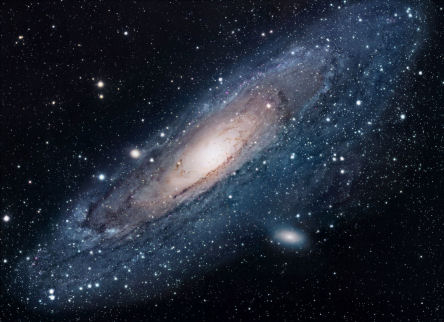Galaxies
|
"The infinitude of creation is great enough to make a world, or a Milky Way of worlds, look in comparison with it what a flower or an insect
does in comparison with the Earth." ~ Immanuel Kant
If our solar system could fit into a coffee cup, then our galaxy (the Milky Way) would be the size of the entire North American Continent! During the 1920's when most astronomers thought the Milky Way was the whole of the Universe, Edwin Hubble realized that the Milky Way was only one of a Universe full of galaxies. He classified them into a system that is known as the "tuning fork." Elliptical galaxies are sorted by how round or or stretched out they appear. An E0 galaxy is very round and an E7 galaxy is very elliptical. The higher the number, the more eccentric the ellipse. Some galaxies have a spiral shape, and a bright bar running across the middle. Hubble named these galaxies "barred spiral galaxies."
Both barred and non-barred spiral galaxies are more finely sorted by how tightly their arms are wound to the core. Type "a" have arms wound very tightly to the core and have large central bulges. Type "c" have arms wound loosely and have small central bulges. Some galaxies appear to be between the elliptical and spiral galaxies, they are labeled S0 on the tuning fork. These are called "lenticular galaxies" which means "lens-like." Lenticular galaxies have a central bulge and a disk like the spiral galaxies but no spiral arms. A third class is called "irregular." Irregular galaxies are difficult to classify as spiral or elliptical, and can have almost any shape. Many of these probably result from two galaxies colliding, or by being reorganized by the gravity from a near miss. Galaxies that are extremely odd are sometimes classified as "peculiar."  |

